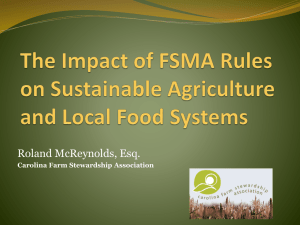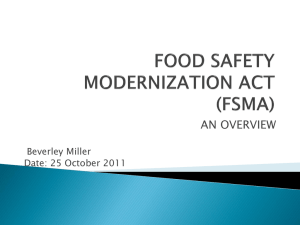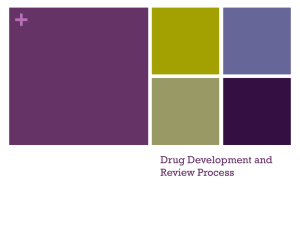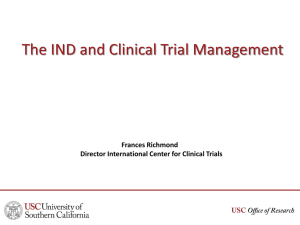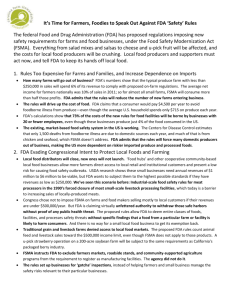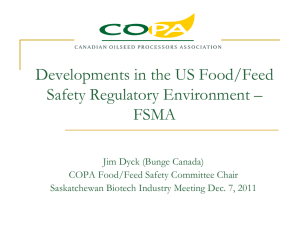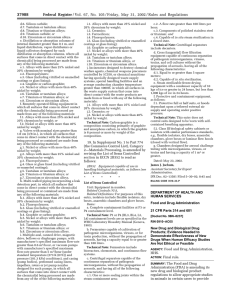This PowerPoint
advertisement
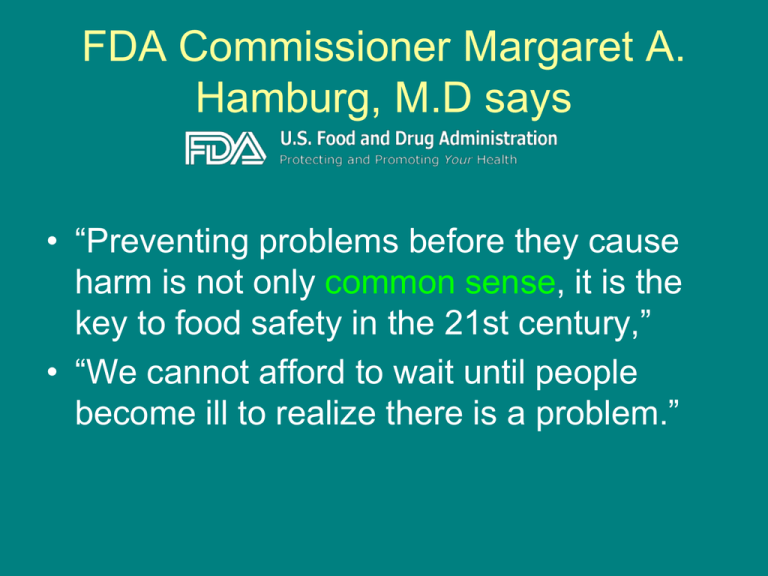
FDA Commissioner Margaret A. Hamburg, M.D says • “Preventing problems before they cause harm is not only common sense, it is the key to food safety in the 21st century,” • “We cannot afford to wait until people become ill to realize there is a problem.” The FDA Food Safety Modernization Act (FSMA) • Prevention is the core principle of the FDA Food Safety Modernization Act that President Obama signed into law in 2011 • The proposed rules will establish requirements for farmers, food companies and importers to prevent foodborne illness. • Proposed rules build on existing voluntary industry guidelines for food safety, which many producers, growers and others currently follow Five Proposed Rules • Produce Safety Standards • Preventive Controls for Human Food • Importer Foreign Supplier Verification • Preventive Controls for Animal Food • Accreditation of Third-Party Auditors • The first rules two have been proposed and published for public comment setting Science-based standards for the prevention of foodborne illnesses Comment Period • The proposed rules have been published in the Federal Register, with a 120-day public-comment period. The rules are filed in FDA’s official docket at www.regulations.gov and can also be accessed at www.fda.gov/fsma • Comment period has been extended until September 16, 2013 Compliance Dates under The New FSMA • Effective 60 days after final rule is published • Very small farms, small farms have up to 2 to 6 years to comply in certain areas Scope of Coverage Under Produce Safety Rule Raw agricultural commodity (RAC) both domestic and imported produce Exemptions: • Products that are not a raw agricultural commodity • Produce for personal or on-farm consumption • Produce that receives commercial processing that adequately reduces the presence of microorganisms (e.g. a ‘‘kill step’’) as long as certain documentation is kept. • The proposed rule would not cover farms that have an average annual value of food sold during the previous three year period of $25,000 or less • The proposed rule would provide a qualified exemption and modified requirements for farms that meet two requirements: (1) The farm must have food sales averaging less than $500,000 per year during the last three years; and (2) the farm’s sales to qualified end users must exceed sales to others. A qualified end-user is either (a) the consumer of the food or (b) a restaurant or retail food establishment that is located in the same State as the farm or not more than 275 miles away. Scope of Preventative Controls Rule • Applies to facilities that are required to register with FDA under FDA’s current food facility registration regulations • Exemption – (1) During the 3-year period preceding the applicable calendar year, the average annual monetary value of the food manufactured, processed, packed or held at such facility that is sold directly to qualified end-users (as defined in this part) during such period exceeded the average annual monetary value of the food sold by such facility to all other purchasers; and – (2) The average annual monetary value of all food sold during the 3-year period preceding the applicable calendar year was less than $500,000, adjusted for inflation. Exempted Need to Comment! • This exemption may be withdrawn in the event of an active investigation of an outbreak that is directly linked to the farm Organic • In the case of production that is certified organic, not include any requirements that conflict with or duplicate the requirements of the national organic program established under the Organic Foods Production Act of 1990, while providing the same level of public health protection as the requirements under guidance documents, including guidance documents regarding action levels, and regulations under the FDA Food Safety Modernization Act” (section 419(a)(3)(E)); Proposed Rule: Produce Safety • Proposes requirements that science-based standards be set for growing, harvesting, packing and holding of fruits and vegetables on farms, The standards address major areas specific to agriculture that can be the conduit for contaminants: – – – – – Irrigation and other agricultural water Farm worker hygiene Manure and other additions to the soil Intrusion of animals in the growing fields. Sanitation conditions affecting buildings, equipment and tools – http://www.fda.gov/Food/GuidanceRegulation/FSMA/ucm334114.htm Your Comments Needed • Subpart A—General Provisions – Definition of ‘‘Mixed type facility’’ – How does it pertain to family businesses • Subpart C—Standards Directed to Personnel Qualifications and Training • Subpart D—Standards Directed to Health and Hygiene – comments on the notification and other proposed requirements related to workers health • Subpart E—Standards Directed to Agricultural Water – Comments on testing frequencies – Alternative approaches • Subpart F—Standards Directed to Biological Soil Amendments of Animal Origin and Human Waste – treatment processes acceptable for a biological soil amendment of animal origin – application requirements, minimum application intervals that apply to biological soil amendments of animal origin • Subpart I—Standards Directed to Domesticated and Wild Animals – Working animals • Subpart K—Standards Directed to Growing, Harvesting, Packing and Holding Activities • Subpart L—Standards Directed to Equipment, Tools, Buildings, and Sanitation • Subpart O—Requirements Applying to Records That You Must Establish and Keep Proposed Rule: Preventive Controls for Human Food • Sets safety requirements for facilities that process, package or store food for people. Most human food facilities would be required to have a written plan – http://www.fda.gov/Food/GuidanceRegulation/FSMA/ucm3341 15.htm Plan Requirements – evaluate hazards that are reasonably likely to occur in food, such as pathogens (diseasecausing organisms) and allergens – specify the steps that will be put in place to minimize or prevent those hazards – specify how these controls will be monitored – maintain routine records of the monitoring for verification (is it working) – specify what actions will be taken to correct problems that arise Your Comments Needed • Facilities that “qualify” for exemption – – – – – – Are size classifications appropriate? Should they be more in line with the Produce Rule? Will there be supporting data to define business size Requirements for exempted facilities, are they sufficient Frequency of rechecking for “qualification” Compliance after rule is published is 2 (very small) & 3 (small) years, is this timeframe sufficient? • Minimum requirements for qualified individuals who prepare, validate, review records, reevaluate a food safety plan – Scope of work, standardized curriculum for training, job experience? Is it sufficient? • HACCP (critical control point) / HARPC (risk-based preventative control) shift. Critical limits would not be required for all preventative controls • Should requirements for verifying the monitoring and corrective actions of preventative controls be specified e.g.: – Environmental monitoring, should there be requirements for monitoring Listeria spp, salmonella spp., when and how? Should testing specify pathogen or the indicator organism? – Product testing is not included in the proposed rule, FDA seeks comments if it should be proposed • Written Recall Plan – All types of facilities or modified for certain types – Should FDA be notified if a recall – • Farm mixed-type facility – Do you agree with the FDA qualitative risk assessment of activity/food combinations methodology to determine which is low risk? (table 5 & pg 3690) – Should FDA establish submission requirements to identify above facilities to exempt or modify inspection frequencies • Cross Contact (inadvertent incorporation of an allergen or microorganisms into food) requirements: – Current GMPs recommend containers and carriers of raw materials be inspected on receipt to ensure that their condition has not contributed to the cross contact, contamination or deterioration of food, should it be required? • Training and Education of Personnel – Should this be recommended or required? Should requirements be more specific? • Validation Studies – FDA is seeking comments on decisions to not require scientific studies on allergen labeling controls and sanitation controls. – Is verification activities sufficient? • Records Review – Requirement to review records for the purpose of ensuring preventive controls are effective – After reanalysis of food safety plan, it is found that an identified hazard is reasonably likely to occur, is six weeks enough time to implement additional controls? • Record Retention and Review – 2 year retention for any facility, records to be made available for review and copying at a facility’s place of business at a reasonable time – Should this be modified to require a facility to send records to the FDA and if so, electronically? • Supplier Approval and Verification – Should the above be included in the final rule? Should it be general and/or based on risk? • Customer Complaints – Should the above be included in the final rule to verify that preventive controls are effectively minimizing the occurrence of hazards? • Time and Temp controls for safety – Modifications to the proposed rule for those solely engaged in the storage of unexposed packaged food What are farmers required to do NOW under the new food safety legislation? • Currently food safety programs are voluntary • Any records of food that may be or become adulterated must be assessable to FDA not to exceed 24 hours from the time of receipt of the official request • Food Facilities are required to register • http://www.fda.gov/Food/GuidanceRegulatio n/FoodFacilityRegistration/default.htm • Must comply with the rules set forth by state and local health officials • In some circumstances, must follow commodity guidelines set forth for products associated with past food borne illness outbreaks • Food Safety programs are largely triggered by buyers who are concerned about consumer health and well being Link For More Information • http://www.fda.gov/Food/FoodSafety/FSM A/default.htm Thank You!

